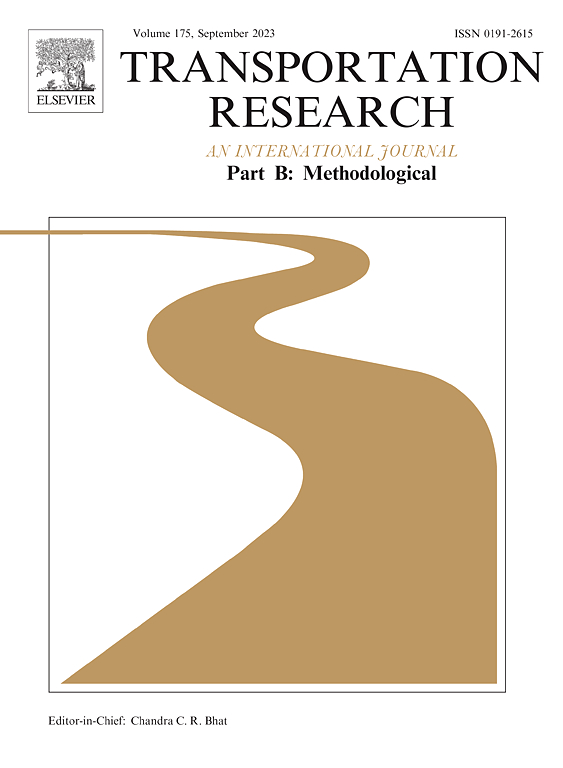从市场份额数据估计市场水平参数的非参数混合logit模型
IF 6.3
1区 工程技术
Q1 ECONOMICS
引用次数: 0
摘要
我们提出了一个非参数混合logit模型,该模型使用市场层面的选择份额数据进行估计。该模型将每个市场视为一个智能体,通过解决多智能体逆效用最大化问题,通过特定于市场的参数来表示口味异质性,解决了现有市场层面选择模型参数估计的局限性。通过仿真研究来评估我们的模型在估计时间、估计精度和样本外预测精度方面的性能。在一个真实的数据应用中,我们估计了纽约州1953万居民的5355万次旅行的出行方式选择。这些旅行是根据人口细分和人口普查分组级别的始发目的地(OD)对进行汇总的,结果是120,740个市场。我们将模型与多项logit (MNL)、嵌套logit (NL)、逆积微分logit (IPDL)和BLP模型进行基准测试。结果表明,该模型将样本外精度从65.30%提高到81.78%,计算时间不到BLP模型估计的十分之一。从我们的模型和基准模型中检索到的价格弹性和转移比率显示出类似的替代模式。此外,我们的模型估计的市场层面参数提供了额外的见解,并促进了它们与运输设计的供给侧优化模型的无缝集成。通过测量驾驶模式的补偿变化,我们发现9美元的拥堵费将影响大约60%的总旅行者。作为供需整合的一个应用,我们表明,在每天5万美元的预算下,50%的交通票价折扣可以带来每天9402次的最大乘客增加。本文章由计算机程序翻译,如有差异,请以英文原文为准。
Nonparametric mixed logit model with market-level parameters estimated from market share data
We propose a nonparametric mixed logit model that is estimated using market-level choice share data. The model treats each market as an agent and represents taste heterogeneity through market-specific parameters by solving a multiagent inverse utility maximization problem, addressing the limitations of existing market-level choice models with parametric estimation. A simulation study is conducted to evaluate the performance of our model in terms of estimation time, estimation accuracy, and out-of-sample predictive accuracy. In a real data application, we estimate the travel mode choice of 53.55 million trips made by 19.53 million residents in New York State. These trips are aggregated based on population segments and census block group-level origin-destination (OD) pairs, resulting in 120,740 markets. We benchmark our model against multinomial logit (MNL), nested logit (NL), inverse product differentiation logit (IPDL), and the BLP models. The results show that the proposed model improves the out-of-sample accuracy from 65.30 % to 81.78 %, with a computation time less than one-tenth of that taken to estimate the BLP model. The price elasticities and diversion ratios retrieved from our model and benchmark models exhibit similar substitution patterns. Moreover, the market-level parameters estimated by our model provide additional insights and facilitate their seamless integration into supply-side optimization models for transportation design. By measuring the compensating variation for the driving mode, we found that a $9 congestion toll would impact roughly 60 % of the total travelers. As an application of supply-demand integration, we showed that a 50 % discount of transit fare could bring a maximum ridership increase of 9402 trips per day under a budget of $50,000 per day.
求助全文
通过发布文献求助,成功后即可免费获取论文全文。
去求助
来源期刊
CiteScore
12.40
自引率
8.80%
发文量
143
审稿时长
14.1 weeks
期刊介绍:
Transportation Research: Part B publishes papers on all methodological aspects of the subject, particularly those that require mathematical analysis. The general theme of the journal is the development and solution of problems that are adequately motivated to deal with important aspects of the design and/or analysis of transportation systems. Areas covered include: traffic flow; design and analysis of transportation networks; control and scheduling; optimization; queuing theory; logistics; supply chains; development and application of statistical, econometric and mathematical models to address transportation problems; cost models; pricing and/or investment; traveler or shipper behavior; cost-benefit methodologies.

 求助内容:
求助内容: 应助结果提醒方式:
应助结果提醒方式:


